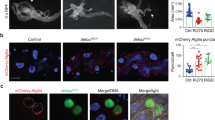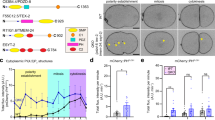Abstract
In the nematode Caenorhabditis elegans, the gonad acquires two U-shaped arms through the directed migration of its distal tip cells (DTCs), which are located at the tip of the growing gonad arms1. A member of the ADAM (a disintegrin and metalloprotease) family, MIG-17, regulates directional migration of DTCs: MIG-17 is synthesized and secreted from the muscle cells of the body wall, and diffuses to the gonad where it is required for DTC migration2. The mig-23 mutation causes defective migration of DTCs and interacts genetically with mig-17. Here, we report that mig-23 encodes a membrane-bound nucleoside diphosphatase (NDPase) required for glycosylation and proper localization of MIG-17. Our findings indicate that an NDPase affects organ morphogenesis through glycosylation of the MIG-17 ADAM protease.
This is a preview of subscription content, access via your institution
Access options
Subscribe to this journal
Receive 12 print issues and online access
$209.00 per year
only $17.42 per issue
Buy this article
- Purchase on Springer Link
- Instant access to full article PDF
Prices may be subject to local taxes which are calculated during checkout




Similar content being viewed by others
Accession codes
References
Kimble, J.E. & White, J.G. On the control of germ cell development in C. elegans. Dev. Biol. 81, 208–219 (1981).
Nishiwaki, K., Hisamoto, N. & Matsumoto, K. A metalloprotease disintegrin that controls cell migration in Caenorhabditis elegans. Science 288, 2205–2208 (2000).
Hedgecock, E.M., Culotti, J.G., Hall, D.H. & Stern, B.D. Genetics of cell and axon migrations in Caenorhabditis elegans. Development 100, 365–382 (1987).
Blelloch, R. & Kimble, J. Control of organ shape by a secreted metalloprotease in the nematode Caenorhabditis elegans. Nature 399, 586–590 (1999).
Komoszynski, M. & Wojtczak, A. Apyrases (ATP diphosphohydrolases, EC 3.6.1.5): function and relationship to ATPases. Biochim. Biophys. Acta 1310, 233–241 (1996).
Wang, T.F. & Guidotti, G. Golgi localization and functional expression of human uridine diphosphatase. J. Biol. Chem. 273, 11392–11399 (1998).
Gao, X.-D., Kaigorodov, V. & Jigami, Y. YND1, a homologue of GDA1, encodes membrane-bound apyrase required for Golgi N- and O-glycosylation in Saccharomyces cerevisiae. J. Biol. Chem. 274, 21450–21456 (1999).
Okkema, P.G., Harrison, S.W., Plunger, V., Aryana, A. & Fire, A. Sequence requirements for myosin gene-expression and regulation in Caenorhabditis elegans. Genetics 135, 385–404 (1993).
Hwang, H.-Y., Olson, S.K., Esko, J.D. & Horvitz, H.R. Caenorhabditis elegans early embryogenesis and vulval morphogenesis require chondroitin biosynthesis. Nature 423, 439–443 (2003).
Goto, S. et al. UDP-sugar transporter implicated in glycosylation and processing of Notch. Nature Cell Biol. 3, 816–822 (2001).
Gilleard, J.S., Barry, J.D. & Johnstone, I.L. cis regulatory requirements for hypodermal cell-specific expression of the Caenorhabditis elegans cuticle collagen gene dpy-7. Mol. Cell. Biol. 17, 2301–2311 (1997).
Hirschberg, C.B. in Transporter of Nucleotides and Nucleotide Derivatives in the Endoplasmic Reticulum and Golgi Apparatus (eds Clapham, D.E. & Ehrlich, B.E.) 105–120 (Rockefeller University Press, New York, 1996).
Selva, E.M. et al. Dual role of the fringe connection gene in both heparan sulfate and fringe-dependent signalling events. Nature Cell Biol. 3, 3809–3815 (2001).
Iino, M., Foster, D.C. & Kisiel, W. Functional consequences of mutations in Ser-52 and Ser-60 in human blood coagulation factor VII. Arch. Biochem. Biophys. 352, 182–192 (1998).
Nishiwaki, K. Mutations affecting symmetrical migration of distal tip cells in Caenorhabditis elegans. Genetics 152, 985–997 (1999).
Brenner, S. The genetics of Caenorhabditis elegans. Genetics 77, 71–94 (1974).
Ketting, R.F., Haverkamp, T.H.A., van Luenen, H.G.A.M. & Plasterk, R.H.A. mut-7 of C. elegans, required for transposon silencing and RNA interference, is a homolog of Werner syndrome helicase and RNaseD. Cell 99, 133–141 (1999).
Mello, C.C., Kramer, J.M., Stinchcomb, D. & Ambros, V. Efficient gene transfer in C. elegans: extrachromosomal maintenance and integration of transforming sequences. EMBO J. 10, 3959–3970 (1991).
Yochem, J., Gu, T. & Han, M. A new marker for mosaic analysis in Caenorhabditis elegans indicates a fusion between hpy6 and hyp7, two major components of hypodermis. Genetics 149, 1323–1334 (1998).
Abeijon, C., Orlean, P., Robbins, P.W. & Hirschberg, C.B. Topography of glycosylation in yeast: characterization of GDP mannose transport and lumenal guanosine diphosphatase activities in Golgi-like vesicles. Proc. Natl Acad. Sci. USA 86, 6935–6939(1989).
Graham, P.L. et al. Type IV collagen is detectable in most, but not all, basement membranes of Caenorhabditis elegans and assembles on tissues that do not express it. J. Cell Biol. 137, 1171–1183 (1997).
Acknowledgements
We thank A. Coulson, A. Fire, Y. Kohara, T. Stiernagle and the Caenorhabditis Genetics Center for materials; and M. Lamphier and A. Spence for critical reading of the manuscript. This work was supported by special grants for PRESTO (K. N.), CREST and Advanced Research on Cancer from the Ministry of Education, Culture and Science of Japan (K. M.).
Author information
Authors and Affiliations
Corresponding author
Ethics declarations
Competing interests
The authors declare no competing financial interests.
Supplementary information
Supplementary Information, Fig. S1
Supplementary Information, Fig. S2 (PDF 2660 kb)
Rights and permissions
About this article
Cite this article
Nishiwaki, K., Kubota, Y., Chigira, Y. et al. An NDPase links ADAM protease glycosylation with organ morphogenesis in C. elegans. Nat Cell Biol 6, 31–37 (2004). https://doi.org/10.1038/ncb1079
Received:
Accepted:
Published:
Issue Date:
DOI: https://doi.org/10.1038/ncb1079
This article is cited by
-
Developmental diseases caused by impaired nucleotide sugar transporters
Glycoconjugate Journal (2013)
-
Prodomain-dependent tissue targeting of an ADAMTS protease controls cell migration in Caenorhabditis elegans
The EMBO Journal (2007)
-
ADAMs, cell migration and cancer
Cancer and Metastasis Reviews (2006)
-
Sweet control of cell migration, cytokinesis and organogenesis
Nature Cell Biology (2004)



